Award of Excellence
Green Roof Innovation Testing (GRIT) Laboratory
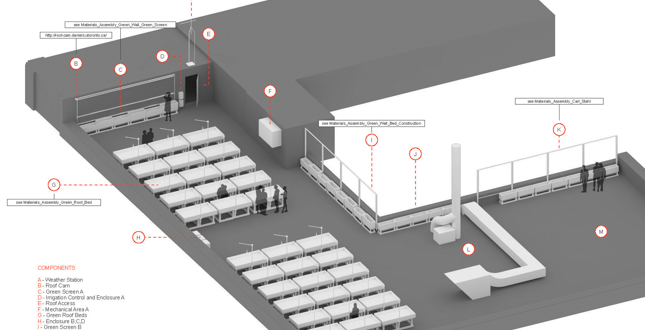 Close Me!
Close Me!A 4,000 sq. ft. roof area is arranged so that thirty-three raised rectangular modules (4 ft. x 8 ft.) can fit within a block formation exposed to sun and wind on all four sides.
Download Hi-Res ImageImage: GRIT Lab
Image 1 of 15
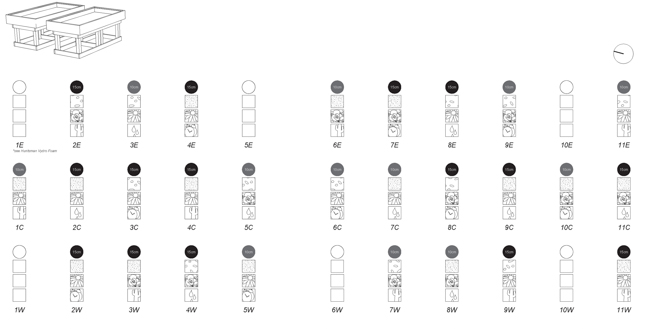 Close Me!
Close Me!Four testing parameters include: 1) growing media type (inorganic/ high organic), 2) growing media depth (4 in./ 6 in.), 3) plant mix (sedum/ grass and forb), and 4) irrigation regimes (none/ timed/ soil-moisture sensor activated).
Download Hi-Res ImageImage: GRIT Lab
Image 2 of 15
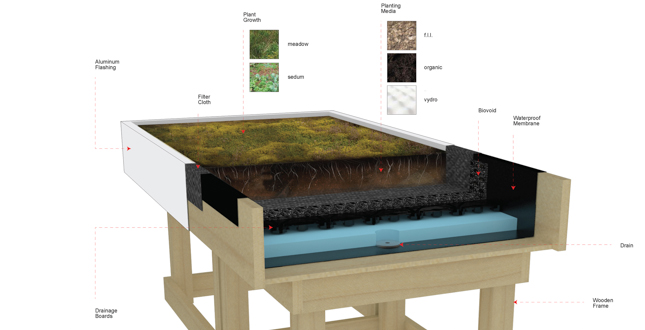 Close Me!
Close Me!Each module simulates green roof construction including roof membrane, foam insulation, parapet and flashing, drainage board, geotextile, filter cloth, growing media and vegetation.
Download Hi-Res ImageImage: GRIT Lab
Image 3 of 15
 Close Me!
Close Me!Fifteen of the modules are seeded with a grass and forb planting mix which is native to Southern Ontario and thought to generate high evapotranspiration rates and resilience over time.
Download Hi-Res ImageImage: GRIT Lab
Image 4 of 15
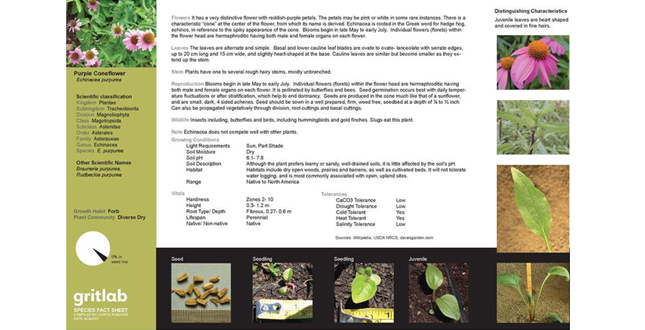 Close Me!
Close Me!Grass and forb plant species fact sheets are made available on the GRIT Lab website.
Download Hi-Res ImageImage: GRIT Lab
Image 5 of 15
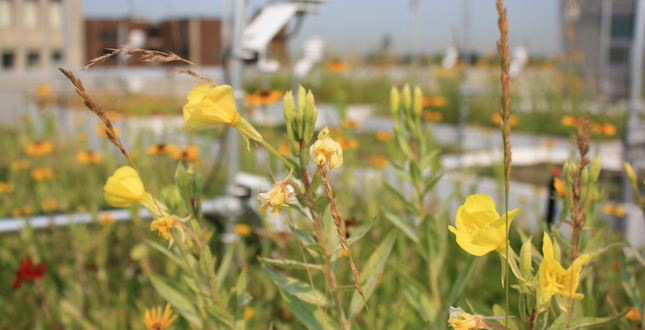 Close Me!
Close Me!A close-up photograph of one of the modules shows the biodiverse grass–forb planting with 6-inch organic growing media and sensor activated irrigation (summer, 2012).
Download Hi-Res ImageImage: GRIT Lab
Image 6 of 15
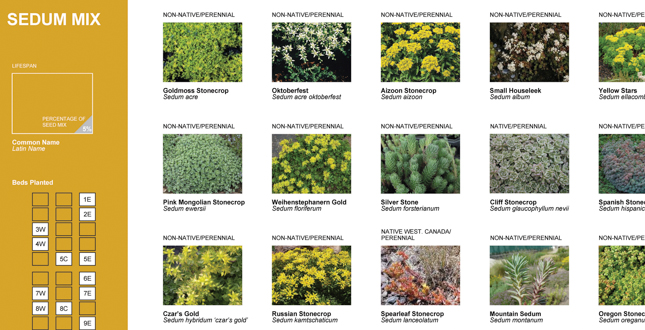 Close Me!
Close Me!Fourteen of the modules are planted with a pre-vegetated sedum mat which represents the current industry standard in North America.
Download Hi-Res ImageImage: GRIT Lab
Image 7 of 15
 Close Me!
Close Me!Sedum species fact sheets are made available on the GRIT Lab website.
Download Hi-Res ImageImage: GRIT Lab
Image 8 of 15
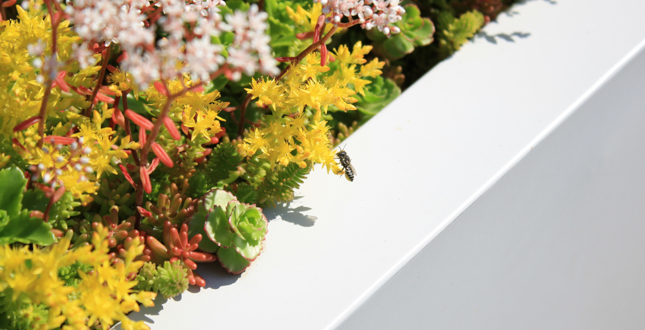 Close Me!
Close Me!A close-up photograph of one of the modules which includes 6-inch organic growing media with sedum planting and timed irrigation (summer, 2012).
Download Hi-Res ImageImage: GRIT Lab
Image 9 of 15
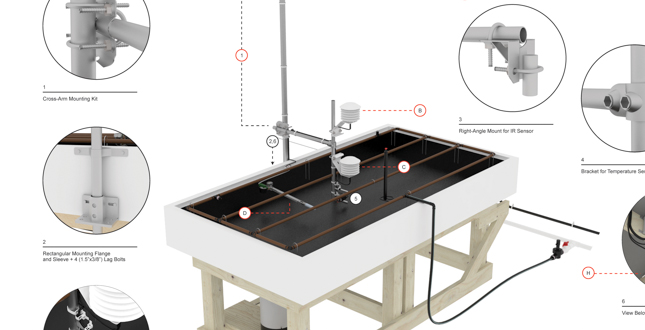 Close Me!
Close Me!Each module is instrumented with a soil moisture sensor, a rain gauge, 5 thermal sensors and an infrared radiometer all of which record hydrological or thermal data every 5 minutes.
Download Hi-Res ImageImage: GRIT Lab
Image 10 of 15
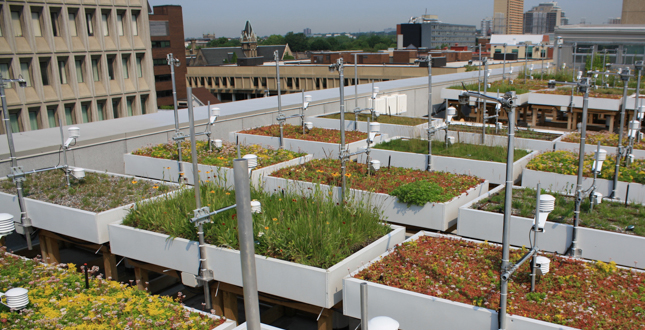 Close Me!
Close Me!A photograph taken in the summer of 2012 shows an apparent difference in plant growth across the various modules and growing conditions.
Download Hi-Res ImageImage: GRIT Lab
Image 11 of 15
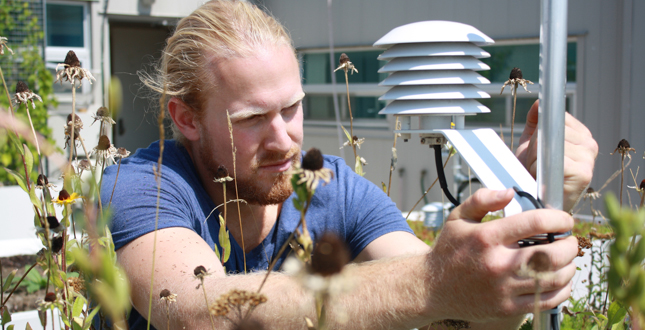 Close Me!
Close Me!Landscape architecture students work directly with the latest material and digital technologies and develop a practical understanding of green roof technologies.
Download Hi-Res ImageImage: GRIT Lab
Image 12 of 15
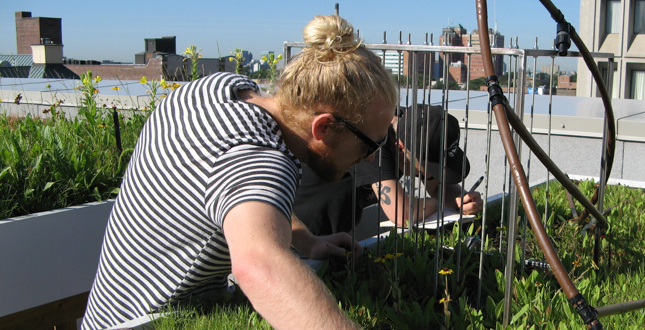 Close Me!
Close Me!A graduate landscape student works together with a biology PhD candidate to conduct a monthly plant cover survey and analysis.
Download Hi-Res ImageImage: GRIT Lab
Image 13 of 15
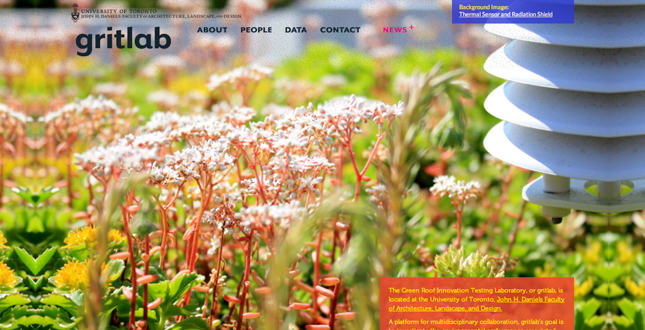 Close Me!
Close Me!The GRIT Lab website is an open source data sharing portal which describes the research objectives and data, academic-industrial-government collaborative, and ongoing activities.
Download Hi-Res ImageImage: GRIT Lab
Image 14 of 15
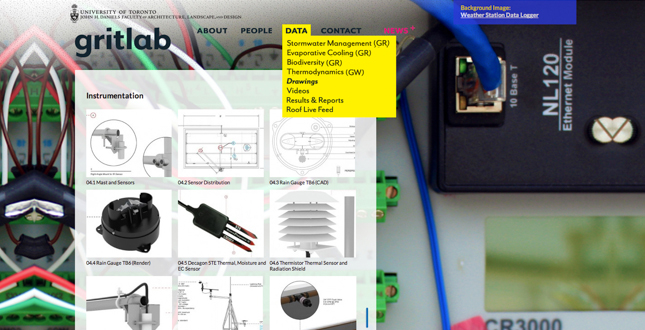 Close Me!
Close Me!The website is updated regularly and include a set of technical drawings, plant data sheets, animations, videos, a link to a live feed, reports, and journal articles.
Download Hi-Res ImageImage: GRIT Lab
Image 15 of 15
Project Statement
The Green Roof Innovation Testing Laboratory (GRIT Lab) is a state-of-the-art research facility and the only one of its kind in North America that studies the optimization of green roof performance. GRIT Lab includes real time data monitoring and ongoing field observation to study the metrics associated with ‘green' technologies in order to provide an unprecedented, comprehensive, dynamic and hands-on understanding of the water–energy–biology nexus in context of regional and climate specific priorities.
Project Narrative
—2013 Professional Awards Jury
Problem Researched
Following the legislation of the City of Toronto's Green Roof Bylaw in 2009, several technical questions emerged regarding the construction standards of green roofs and their associated environmental performance vis-à-vis stormwater management, evaporative cooling and biodiversity. The emergence of these questions can be attributed to insufficient testing of the construction standards in context of the Southern Ontario climate. Despite numerous studies and tests, the standards that have shaped the green roof industry over the years have been developed primarily in context of European climate regions, as opposed to the more extreme range that characterizes Toronto.
Currently, the City of Toronto has no option but to rely on simulation models and metrics derived from other climate regions to determine the success of its green roof construction standard. This may be in part a consequence of the incapacity to legally enter private property for the purpose of monitoring the ongoing maintenance of green roofs and quantifying their environmental performance. In the absence of any means to validate environmental performance, an increasing number of green roof projects herald their success without providing a post-occupancy quantitative evaluation.
The GRIT Lab research project focuses on the following questions: How ‘green' are green roofs? Are the construction standards instituted, taught and practiced effective? Are they appropriate to a specific climate region and do they operate optimally over time?
Relationships Investigated
The research facility is set up to evaluate four testing parameters––1) growing media type (inorganic / high organic), 2) growing media depth (4” / 6”), 3) planting (non-native Sedum / native grass and forb), and 4) irrigation regimes (none / timed / soil-moisture sensor activated) ––with respect to four primary environmental criteria–– 1) Stormwater Retention, 2) Evaporative Cooling, 3) Biodiversity, and 4) Life Cycle Cost.
The hypothesis is that the high organic growing media will provide higher water retention than the inorganic media, and that its nutrient availability will facilitate a sustained and robust plant growth, which will then maintain a lower ambient temperature due to increased evapotranspiration.
It is also hypothesized that the greater depth will provide the thermal mass for the prolonged cold winters in Southern Ontario, which will then ensure annual plant recovery in spring. Lastly, it is thought that the grass and forb planting will yield higher evapotranspiration rates in contrast to the sedum species and will demonstrate a higher resilience over time due to its functional biodiversity in contrast to the Sedum's singular functionality.
Comparison with Past Research
Typically, green roof studies are conducted within the fields of Biology, Hydrology and Building Science and tend to focus on individual components or functions pertaining to their specialized field of study. The GRIT Lab approach is unique for its multi-disciplinary collaborative structure and for its simultaneous examination of plant growth, soil science, hydrology and energy for their mutual capacity to evapotranspire and reduce urban heat island effect; regulate water flow and minimize runoff and irrigation demand; and maintain a robust plant growth over time. Hence, the research team includes faculty members and graduate students from the landscape architecture, engineering – hydrology and energy modeling and biology departments.
Method of Inquiry
A 4,000 sq. ft. section of a roof has been dedicated to conducting the experimental aspect of this research. Thirty-three modules (4 ft. x 8 ft.) have been designed to compare the aforementioned testing parameters. Each module is instrumented with eight sensors: a soil moisture sensor; a rain gauge measures runoff flow rates; five thermal sensors along a vertical axis generate a thermal profile; and an infrared radiometer records the average surface temperature of a 3 ft. diameter circle. The data acquired from the 264 sensors is statistically analyzed in relation to plant growth and in relation to the base-climate data (solar radiance, temperature, precipitation, relative humidity, wind speed and direction) acquired via a weather station on-site.
Results of Research
The facility's construction and instrumentation began in 2010 and was completed in the winter of 2012. Hydro-energy and plant growth data will be collected for the next 3 years. Preliminary results to date are based on the field observation of plant growth over the last 2 growing seasons, which include an inventory of plant cover, species biodiversity and height in relation to growing conditions in each test bed. The findings demonstrate that supplemental irrigation is required to maintain the plant diversity and that grass and forb vegetative cover and biomass were significantly greater in organic based growing media. The lack of irrigation in the inorganic growing media resulted in almost a complete loss of grass and forb plant cover; neither irrigation nor growing media had any effect on the Sedum plant cover.
Significance of the Results
The wide range of partnerships GRIT Lab has established with academic institutions, industry partners and government agencies have far reaching implications for education and knowledge transfer, innovation and commercialization, as well as policy and guidelines. It is expected that the research findings will augment the City of Toronto's Green Roof Constructions Standard as well as industry standards and GRP accreditation programs.
Communication
The GRIT Lab website presents an open source data sharing portal, which currently includes a set of original technical drawings, plant data sheets, animations, videos and a link to a live feed all of which are meant to describe the experimental design, process and ongoing activities at the lab. Research findings, reports and journal articles will be updated regularly.
Applicability to Landscape Architecture Practice and Education
The results of the study are specific to Southern Ontario, however, the study's approach and experimental design is transferable across regions. Landscape architects may have a better understanding of how to define the environmental performance objectives of green roof systems in relation to their own regional and climate specific priorities and become more equipped to discuss these priorities with their material vendors and sub-consultants.
Finally, one of the primary objectives of GRIT Lab is to develop a unique hands-on opportunity for landscape students to work directly with the latest material and digital technologies, as well as with both industry experts and academics from a wide range of disciplines. The cross-pollination among various disciplines is intended to generate new ideas, while the link to industry and government agencies facilitates their implementation.
Project Resources
Principal Investigator
Liat Margolis, Assoc. ASLA
Co-Researchers
Robert Wright, ASLA
Ted Kesik
Brent Sleep
Liam O'Brien
Jennifer Drake
Assistant Researchers
Jenny Hill
J. Scott MacIvor
Benjamin Matthews, Student Affiliate ASLA
Matthew Perotto, Student ASLA
Curtis Puncher
Catherine Yoon
Facility Management
University of Toronto
Website Design / Development
Kristina Ljubanovic / Mahan Javadi
Liat Margolis, Assoc. ASLA
Granting Agencies
City of Toronto Environment Office
Connaught Fund
Landscape Architecture Canada Foundation (LACF)
MITACS
Natural Sciences and Engineering Research Foundation of Canada (NSERC)
Ontario Centres of Excellence (OCE)
RCI Foundation
Industry Contributors
Bioroof Systems
Carl-Stahl-Decorcable
DH Water Management
Flynn
Greenscreen
Hunstman Polyurethanes
IRC Building Sciences Group
Scott Torrance Landscape Architect Inc.
Schletter
Semple Gooder
Siplast
Sky Solar
TerraGen Solar
Toro
Tremco Roofing
Featured Products
Irrigation Equipment
Toro
Irrigation Design & Installation
DH Water Management
Green Roofs Growing Media & Vegetation
Bioroof Systems
Green Facades
Carl-Stahl-Decorcable, Greenscreen
Roofing Materials and Installation
Tremco Roofing, Siplast, Semple Gooder
Sensor Equipment
Campbell Scientific, Irrometer Co.
Engineering Consulting
IRC Building Sciences Group




